 Research Article
Research Article
Evaluation of Plant-Based and Commercially Available Flocculant-Disinfectants for Water Purification
Akinbolawa Olujimi A1, Oloruntoba, Elizabeth O1, Olu Owolabi Bamidele I2, Micheal Abimbola Oladosu3, Moses Adondua Abah4*, Wasiu Adisa Abdulrasaq5, Godman Eneojo Sule6, Agbanigo Bolade Sunday7, Agbanigo Ufuoma Blessing8 and Adewale Femi Emmanuel9
1Department of Environmental Health Sciences, Faculty of Public Health, College of Medicine, University of Ibadan, Ibadan, Oyo State, Nigeria
2Department of Chemistry, Faculty of Science, University of Ibadan, Ibadan, Ibadan, Oyo State, Nigeria
3Department of Biochemistry, Faculty of Basic Medical Sciences, University of Lagos, Lagos State, Nigeria
4Department of Biochemistry, Faculty of Biosciences, Federal University Wukari, Taraba State, Nigeria
5Department of Chemical Engineering, Faculty of Engineering and Technology University of Ilorin, Ilorin, Kwara State, Nigeria
6Department of Chemistry, Faculty of Science, Adekunle Ajasin University Akungba
7Department of Dental Surgery, Faculty of Dentistry, College of Medicine, University of Ibadan, Oyo State, Nigeria
8Department of Medicine and Surgery, Faculty of Clinical Science, College of Medicine, University of Ibadan, Oyo State, Nigeria
9Department of Energy and Applied Chemistry, Faculty: Faculty of Science, Usmanu Danfodiyo University Sokoto
Moses Adondua Abah, Department of Biochemistry, Federal University Wukari, Taraba State, Nigeria
Received Date:June 02, 2025; Published Date:June 23, 2025
Abstract
Many chemical coagulants are reportedly widely used in conventional water treatment processes for tap water production. However, studies have reported that all these chemicals lead to many health problems The effectiveness of three treatment strategies- Moringa oleifera seed powder (MOSP), Moringa oleifera seed powder combined with Household Ceramic Filter (MHCF) and a powdered conventional water purifier (CWP) were assessed for the purification of water from two hand dug wells. Treatment of well A was with MOSP, MHCF and CWP produced 94.48%, 94.98% and 94.96% turbidity reduction respectively. Treatment of well B was with MOSP, MHCF and CWP produced 85.84%, 94.54% and 95.11% turbidity reduction respectively. The results obtained in this study revealed that the microbial quality of the water samples were within WHO and SON regulatory limits. Water treatment with Moringa oleifera seed powder in combination with household ceramic filtration was comparatively as effective as treatment CWP for water purification. Findings of this study lend support to earlier works recommending the use of Moringa oleifera for water purification. This study has also shown that both treatment with MHCF and CWP, present viable alternatives for the replacement or reduction of the dosage of the coagulation chemicals employed in the process of treating water. It is recommended that the viability and acceptability of these products be investigated at households and communities as water treatment options after carrying out tests to certify the non-toxicity of the products.
Keywords: Moringa oleifera; Household ceramic filtration; Flocculant-disinfectants; Water purification; Turbidity
Introduction
Water is crucial as an essential component of life. The quality and accessibility of drinking water are of paramount importance to human health. Drinking water may contain disease- causing agents and toxic chemicals and to control the risks to public health, systematic water quality monitoring, surveillance and treatment are required [1,2]. In Nigeria, just like many developing countries of the world, access to potable water for many of the citizens has become a mirage. According to the World Bank in 2000, it is estimated that about 50% of the urban and 20% of the semi-urban population have access to reliable water supply of acceptable quality. However, a WHO/UNICEF Joint Monitoring Programme for Water Supply and Sanitation report [3] for Nigeria indicated by total estimates of both urban and rural areas that from 1990 to 2015, drinking water coverage for water piped onto premises reduced from 12% to 2%; other improved source rose from 28% to 67%; unimproved source fell from 23% to 21%, and surface water source fell from 37% to 10%, in that order.
Exploitation of groundwater through the construction of hand dug wells, as is majorly done for instance in Obantoko area of Abeokuta, is a major source of drinking water for majority of the populace [4]. In order to meet daily demand in Abeokuta, groundwater is being considered a better alternative to supply from public sources that are irregular [5]. However, water from all sources must have some form of purification before consumption. Various methods are used to make water safe and attractive to the consumer. The method employed depends on the quality of the raw water [6]. Many chemical coagulants are widely used in conventional water treatment processes for tap water production. However, studies have reported that all these chemicals lead to many health problems [7]. The use of natural material of plant origin to clarify turturbid raw water is not a new idea. Naturally occurring coagulants are biodegradable and presumed safe for human health [8]. The broad objective of this study is to evaluate the effectiveness of Moringa oleifera seed powder, Moringa oleifera seed powder combined with household ceramic filtration and powdered conventional water purifier for the purification of water from hand dug wells.
Materials and Methods
Study Design
A laboratory-based experimental design was used for the study. Water samples collected from hand dug wells were subjected to three treatments: treatment with powder from Moringa oleifera (Lam.) seeds (MOSP); treatment with MOSP combined with Household Ceramic Filter (MHCF); and treatment with a powdered Conventional Water Purifier (CWP). Untreated water (raw water) samples were used as controls. The MOSP and CWP samples were cloth filtered to remove suspended particles.
Study Location
This study was carried out in Surulere-Oke Odo community and Obantoko ward, Odeda Local Government Area, Abeoukuta, Ogun State. Odeda local Government is one of the twenty Local Governments in Ogun State of Nigeria. There are about 25- 30 semi-urban areas and 860 villages and hamlets in the local government area and the people are pre-dominantly Egba who have their homesteads and farm lands in the area. It is remarkable to note that the local government play host to the Federal University of Agriculture, Abeokuta; Federal College of Education, Osiele; Ogun, Oshun River Basin Development Authority; and State Headquarters of Nigeria Police, Eleweran.
Selection of Wells
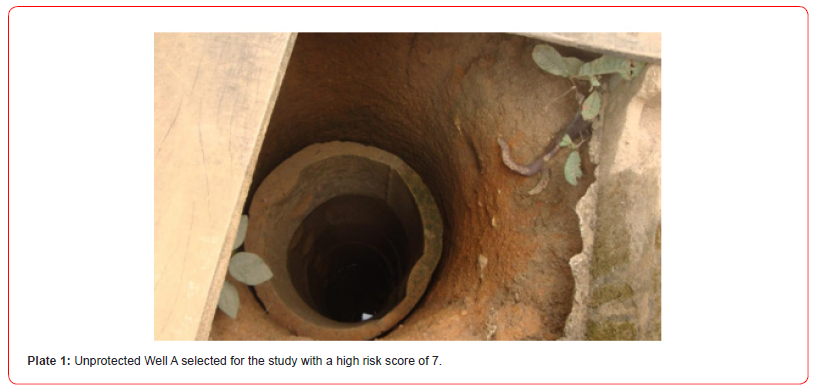
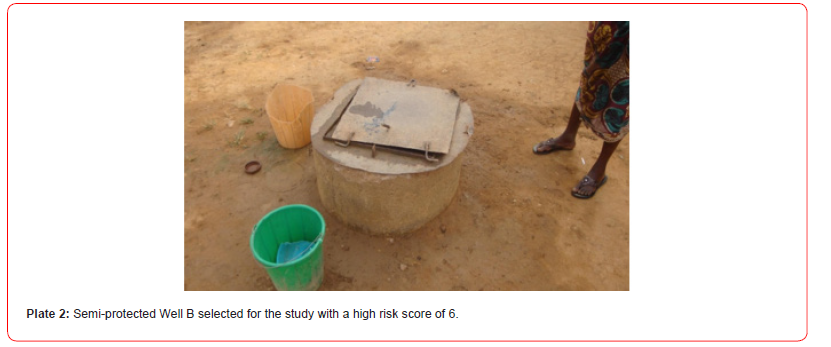
A Sanitary survey form (Appendix I) for the assessment of the risks of contamination of drinking water sources (dug wells) was used for the wells in the study area. The criteria used for the selection of wells for this study include the identification of sanitary risk factors. The sanitary risk score is on a scale of 1 to 12, with the following categorizations: 1- 2 = Low risk; 3- 5 = Moderate; 6- 8 = High risk; 9- 12 = Very high risk. Two of the thirty wells inspected (Plates 1 and 2) with the highest risk scores were purposively selected for the study. The wells were designated Well A (an unprotected well) and Well B (a semi-protected well). An unprotected well has inadequate sanitary completion which is usually characterized by a poor well head protection and no concrete slab or apron. A protected well comprise of a completely sealed well head, a concrete slab and an apron. A semi-protected well is somewhere in-between these definitions).
Sampling Techniques
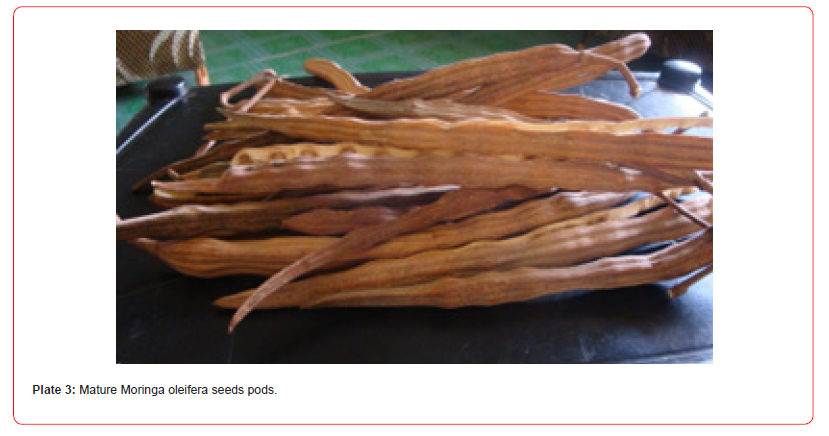
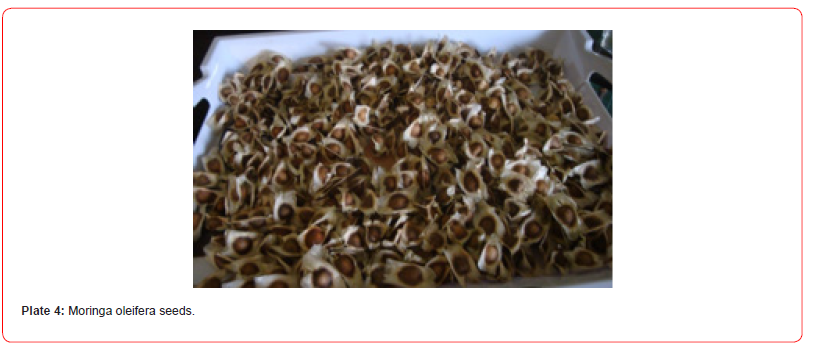
Water samples were collected according to recommended standard methods described by the method of Pillai (2009). Baseline samples were collected once a week for three weeks, in the morning and evening. These samples were analyzed for physicochemical and bacteriological baseline characteristics. At the fourth week of the study, kegs of 25Litre capacity were used to collect samples for laboratory experiments with the treatment methods. Thoroughly washed and sterilized bottles were used to collect samples for bacteriological analysis. One litre (1000mL) capacity plastic dispense bottles were used to collect samples for physicochemical parameters analysis. Samples in the sterile and plastic dispense bottles were placed in light proof insulated box containing ice pack to preserve the samples. Analyses were carried out in the laboratory within 48hrs of collection (for physicochemical analysis) and 6hrs (for the bacteriological analysis).
Preparation of Moringa oleifera Seeds
Mature seeds of Moringa oleifera seeds pods (Plate 3) were obtained from the study area (there are many households in the area cultivating the plant). The seeds (Plate 4) were removed manually from the shell and blended with a blender. The seed powder was then sieved to obtain a seed powder on a sieve of 10mm mesh size.
Coagulant Solution Preparation
Mature, naturally dry and brown seed pods of Moringa oleifera were harvested from the tree and shelled. The seed kernels were crushed and sieved with a sieve of 10mm mesh size. Stock coagulant solution (1%) was prepared by dissolving powdered Moringa oleifera seed in distilled water. 3.0grams of the crushed seed powder was carefully weighed and mixed with little distilled water to form a suspension, then filtered to remove the insoluble materials and diluted to make up 300mls (1% strength). One millilitre of this stock solution is equivalent to 10mg/l when added to 999ml of water to be tested.
The Jar Test Experimental Procedure
The jar test apparatus with six beakers of 1000ml capacity was used as seen in Plate 5. Each beaker was filled to the 999ml mark with raw water. A rate per minute gauge at the top of the device allows for the uniform control of the mixing speed in all the containers. The coagulant was added to each container and stirred at 250 rotation per minute (rpm) for 1 minute. The rapid mix stage helped to disperse the coagulant throughout each container. The stirring speed was then reduced to 25rpm and the mixing continued for 20 minutes. This slower mixing speed helped to promote flocculation by enhancing particle collisions. Using the prepared stock solution of the powdered Moringa oleifera seed, the six beakers were each dosed with increasing amounts (50mg/l, 60mg/l, 70mg/l, 80mg/l, 90 mg/l, and 100 mg/l) of the Moringa oleifera solution [9].
Preparation of the Conventional Water Purifier
Pur® flocculant/disinfectant powder was purchased from Kuto market, in Abeokuta, Ogun State, Nigeria. The Pur® powder was designed to treat raw water by incorporating the multiple barrier processes of removal of particles and disinfection. The treatment process is illustrated in Figure 1. (A satchet of the Pur® powder can treat 10L of raw water).
Household Ceramic Filter
A water filter fitted with porous ceramic candles and enclosed in stainless steel container (Plate 6) was purchased from a store in Abeokuta. The water filter consists of an upper and lower containers, two porous ceramic candles in between, a tap and a lid. The containers have a diameter of about 30cm by 25cm depth for the treatment capacity of about 10L and a flow rate of about 4L per hour through the two candles. The porous ceramic candles are screwed into the base of the upper container. To the lower container is attached a tap that allowed safe water withdrawal without risking recontamination. A lid placed on the upper container helped to prevent contamination. Water poured into the upper container passed through the candles and was collected in the lower container. Turbidity, suspended materials and pathogens were removed from the water through mechanical trapping and adsorption in the micro-scale pores of the ceramic candles.
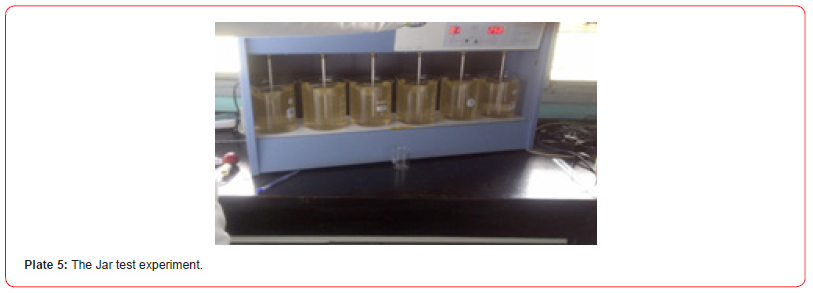


Physicochemical Analysis
Physico-chemical characteristics such as pH, turbidity, chloride, hardness, alkalinity, and nitrate (as N) were determined according to the standard methods described by the method used by Pillai [10] and Iheanacho et al. [11].
Bacteriologial Analysis
The multiple tube fermentation method was adopted in determining the most probable number of coliforms that were present in each raw water (control) and treated water samples. This involved two stages – the presumptive test (using MacConkey Broth) and the confirmed test (using Brilliant green lactose bile broth) [10]. Each water sample was prepared in four dilution categories: 10ml of undiluted sample (in double strength), 1ml of undiluted sample (in single strength), two serial dilutions of 1:10 (in single strength) and 1:100 (in single strength). The 1:10 dilution series was prepared by pipetting 1ml from the original sample and diluting to 10ml with 9ml distilled water, while the 1:100 dilution series was prepared by diluting 1ml of sample from 1:10 dilution and diluting to 10ml with 9ml distilled water. All the dilutions (distilled) water were sterilised in an autoclave at 121°C for 15minutes.
Health-Based Performance Targets
Performance targets are values, expressed in terms of log10 reductions in microbe concentrations, that define treatment requirements in relation to source water quality. Three recommended levels of performance for the reduction of bacteria, viruses and protozoa are illustrated in Table 1.
Table 1:Summary of performance requirements for small-scale and household drinking water treatment.

Source. WH0 (2011).
The health-based performance targets of the treatments were
computed as:
log10 (Cuntreated water / Ctreated water).
where C = microbe concentration in water
Data Analysis
Data from the laboratory experiment was recorded in a prepared data sheet. Data was analyzed using SPSS statistical package. Descriptive statistics (mean and the corresponding standard deviation) were used to summarize data. Tables, bar charts and line graph were used for data presentation. The analysis of variance (ANOVA) and the F-test were used to compare mean values of the parameters for the treatment methods. The level of the significance was set at 5% to assess whether there exist significant variations among the treatments given to evaluate the effectiveness of the water treatments demonstrated in the study.
Results
Table 2 shows the results of physico-chemical analysis of raw water samples collected from two wells labelled (Well A and Well B) in the study area. It also shows the permissible limits as recommended by the Standards Organisation of Nigeria (SON), [12], for drinking water and World Health Organistaion (WHO), 2011, standard for potable water. The table reveals that the levels of the water quality parameters such as turbidity, the Total alkalinity, and Total hardness, and Cacium hardness values were much higher than the guideline limits. These values were higher compared to the SON and WHO recommended limits for potable water. Results of bacteriological analysis showed less than 10/100ml coliform organisms present in water samples from the two wells.
Table 2:Characteristics of raw water samples from Well A, and Well B.
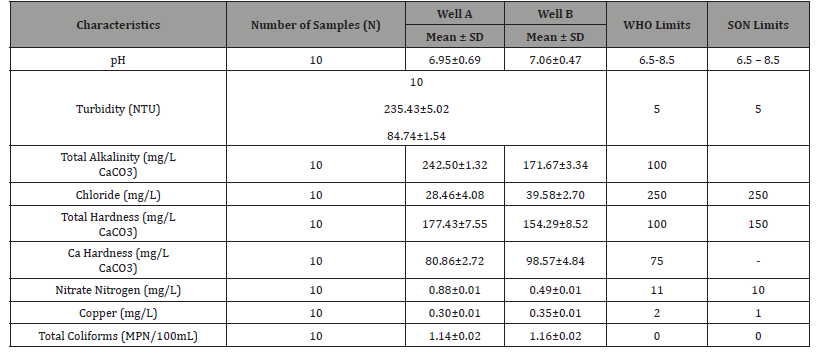
Coagulation of raw water samples from Well A with MOSP
The result of the jar test and laboratory analysis of the water sample from Well A is presented in Figure 2. The turbidities were reduced compared to the raw water turbidity of 235.43±5.02 NTU as against 16.40±3.27 NTU (93.03%), 16.40±3.25 NTU (93.03%), 13.20±2.25 NTU (94.39%), 21.70±3.26 NTU (90.78%), 18.80±2.27 NTU (92.01%), and 21.30±3.27 NTU (90.95%) recorded for 50mg/L, 60mg/L, 70mg/L, 80mg/L, 90mg/L and 100mg/L respectively of the MOS. It is shown from the figure that 70mg/L dosage of MOSP showed the highest turbidity reduction and was, therefore, the optimum concentration of coagulant selected for the final treatment of water sample from Well A.
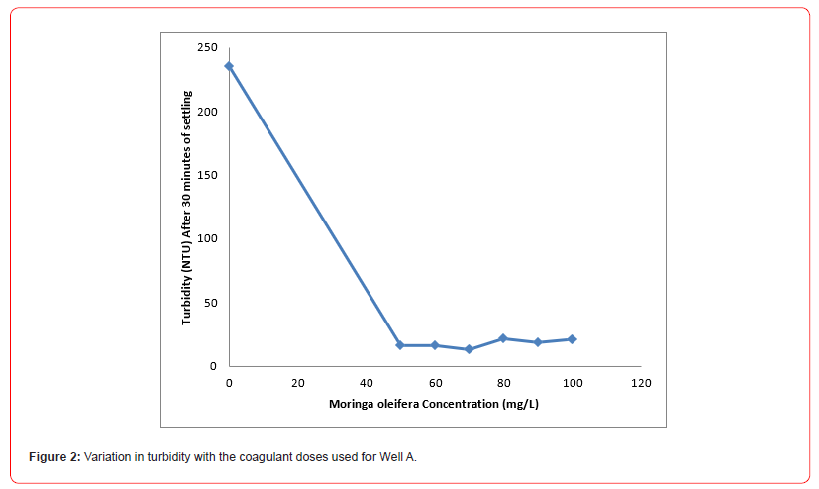
Coagulation of raw water samples from Well B with MOSP
The result of the jar test and laboratory analysis of the water sample from Well B is presented in Figure 3. The turbidities were reduced compared to the raw water turbidity of 84.74±0.02 NTU as against 17.90±2.50 NTU (78.88%), 17.50±2.00 NTU (79.35%), 16.00±2.02 NTU (81.12%), 18.40±2.10 NTU (78.29%), 13.90±2.00 NTU (83.60%), 12.10±2.08 NTU (85.72%) recorded for 50mg/L, 60mg/L, 70mg/L, 80mg/L, 90mg/L and 100mg/L respectively of the MOSP. It is shown from the figure that 100mg/L dosage of MOSP showed the highest turbidity reduction and was, therefore, the optimum concentration of coagulant selected for the final treatment of water sample from Well B.
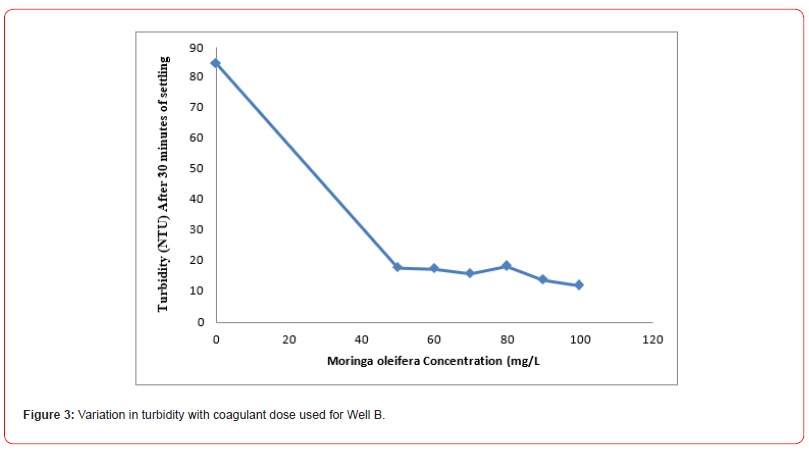
Effect of MOSP, MHCF, and CWP Treatments on Well A Water quality
Tables 3 shows the effects of the treatment methods on raw water sample from Well A. The reductions in the mean turbidity levels were statistically significant (F= 8.541, p= 0.006). Table 4 shows the health-based performance of the three treatment methods on Well A. MOSP and CWP are designated protective based on their respective log10 reduction values of 2.06 each. MHCF however had a log10 reduction value of 1.76 and hence designated interim.
Table 3:Effect of treatment with MOSP, MHCF, and CWP on the physicochemical and bacteriological qualities of Well A.
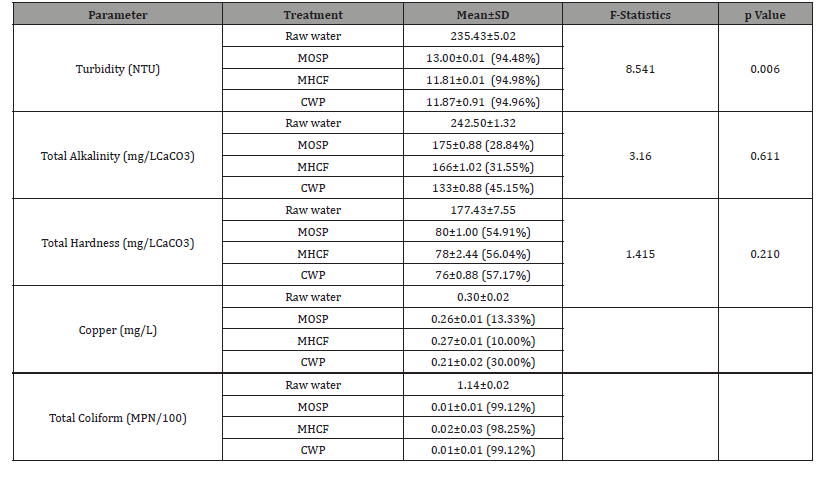
Table 4:Health-Based Performance of MOSP, MHCF and CWP treatments on Well A.

Effect of MOSP, MHCF, and CWP Treatments on Well B Water quality
Tables 5 shows the effects of the treatment methods on raw water sample from Well B. The reductions in the mean turbidity levels were statistically significant (F= 2.221, p= 0.001).
Table 6 shows the health-based performance of the three treatment methods on Well B. MOSP and MHCF are designated interim based on their respective log10 reduction values of 1.76 and 1.59 respectively. CWP however had a log10 reduction value of 2.06 and hence designated protective.
Table 5:Effect of treatment with MOSP, MHCF and CWP on the physico-chemical and bacteriological qualities of Well B.
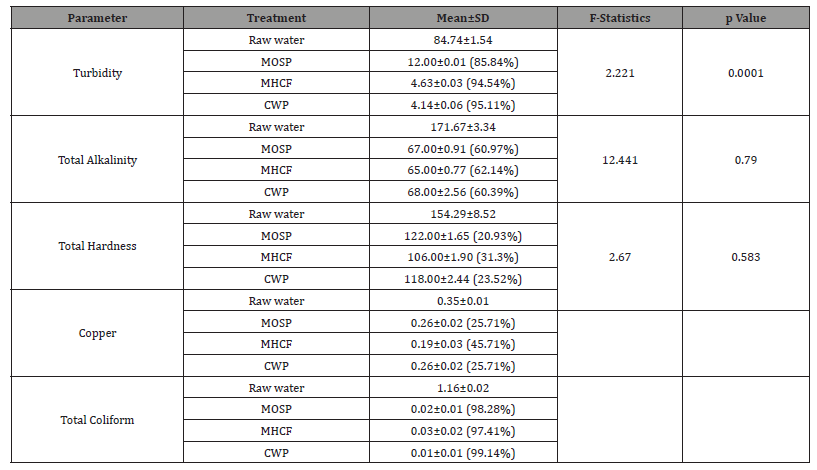
*(Values in parenthesis are % reduction).
Table 6:Health-based performance of MOSP, MHCF and CWP treatments on Well B.

Discussion
Water from all sources must have some form of purification before consumption. Various methods are used to make water safe and attractive to the consumer. The method employed depends on the quality of the raw water [6,13]. Many chemical coagulants are widely used in conventional water treatment processes for tap water production. However, studies have reported that all these chemicals lead to many health problems [7,14]. In this study, the effectiveness of three treatment strategies- Moringa oleifera seed powder (MOSP), Moringa oleifera seed powder combined with Household Ceramic Filter (MHCF) and a powdered conventional water purifier (CWP) were assessed for the purification of water from two hand dug wells
A comparison of the mean turbidity values of the raw water (control), MOSP, MHCF, and CWP samples revealed that there was significant difference among them (p=0.05). This showed that the treatments were effective in reducing the turbidity of highly turbid water. The turbidity values for all the treatments were higher than the WHO and SON limits in Well A. In Well B, MOSP treatment had a turbidity value higher than the regulatory limits, but MHCF and CWP treatments had turbidity values within the regulatory limits. The MHCF treatment was the most effective of the three treatments for reducing turbidity in Well A and has comparatively similar effect with CWP in Well B. These findings are supported by another study carried out in Anambra, Nigeria by Oria-Usifo, et al. [15] who reported a 92.30% reduction in turbidity within 1hour settling period for initial turbidities ranging 64NTU using M. oleifera dosages of 30-120mg/l. Another recent study by Ezhilarasi and Veerasekar [8] reported turbidity removal of the order of 95% using M. oleifera extract. This same study reported a 77% reduction in total coliform using M. oleifera extract.
There was observable decrease in the mean total alkalinity and total hardness values for MOSP, MHCF, and CWP treatments in both Well A and Well B. These values were however, not statistically significant. In Well A, treatment with MHCF was the most effective of the three treatments in reducing alkalinity and hardness. Similar observation in Well B showed treatment with MHCF to be most effective in reducing alkalinity and hardness. This could be as a result of effective trapping and adsorption in the micro-scale pores of the ceramic candles of the calcium and magnesium salts in the water samples. A similar study by Pakki and Malla [16] who investigated the characteristics of water samples treated with Moringa oleifera from four rivers in Gajapati, India found that the residual hardness decreased with increased dosage of M. oleifera. It was also observed that for the same initial hardness, water samples containing both calcium and magnesium hardness required higher doses of M. oleifera than those containing only calcium hardness.
The health-based performance of the MOSP, MHCF and CWP treatments were determined by applying the concept of tolerable disease burden (acceptable risk) as set out in the Guidelines for Drinking Water Quality (WHO, 2011). A comparison of the health –based performance for the three treatments showed MOSP to have protective and interim effects in Wells A and B respectively, MHCF to have interim effects in both wells, and CWP to have protective effects in both wells. Treatment of water samples from both Well A and Well B with CWP has the highest health-based performance in terms of Log10 reduction values. Crump et al. [6] in a similar evaluation of a combined flocculant-disinfectant point-of-use water treatment (Pur® powder) reported a 97% reduction in bacterial concentration and 87% reduction in turbidity of treated water samples.
Conclusion
This study has shown that both treatment with MHCF and CWP, present viable alternatives for the replacement or reduction of the dosage of the coagulation chemicals employed in the process of treating water. It is recommended that the viability and acceptability of these products be investigated at households and communities as water treatment options after carrying out tests to certify the non-toxicity of the products.
Conflicts of Interest
All authors declare that they have no conflict of interest associated with this research article.
Acknowledgements
We acknowledge all authors of this research work for their participation.
Funding
No special funding was received for this research work.
References
- Guidelines on Drinking Water Quality (2011) 4th Edn, World Health Organization, Geneva, Switzerland. ISBN 9789241548151.
- Vikashni N, Matakite M, Kanayathu K, Subramanium S (2012) Water Purification using Moringa oleifera and Other Locally Available Seeds in Fiji for Heavy Metal Removal. Intrenational Journal of Applied Science and Technology 2(5): 125-129.
- WHO/ UNICEF Joint Monitoring Programme for Water Supply and Sanitation (2015) Estimates of the use of Water Sources and Sanitation Facilities. Nigeria.
- Ayantobo OO, Oluwasanya GO, Idowu OA, Eruola AO (2013) Water Quality Evaluation of Hand-Dug Wells in Ibadan, Oyo State, Nigeria. Global Journal of Science Frontier Research in Agricultire and Veterinary 13(10): 2249-4626.
- Aladejana JA, Talabi AO (2013) Assessment of Groundwater Quality in Abeokuta Southwestern, Nigeria. International Journal of Engineering and Science 2(6): 21-31.
- Crump JA, Okoth GO, Slutsker L, Ogaja DO, Keswick BH et al. (2004) Effect of Point-of-Use Disinfection, Flocculation and Combined Flocculantion-Disinfection on Drinking Water Quality in Western Kenya. Journal of Applied Microbiology 97(1): 22-231.
- Rajendran R, Balachandar S, Sudha S, Muhammed A (2013) Natural Coagulants- An Alternative to Conventional Methods of Water Purification. International Journal of Pharmaseutical Research and Bio-science 2(1): 306-314.
- Ezhilarasi M, Veerasekar N (2014) Water Treatment using Moringa oleifera Seeds and Kernels in Stream Water. International Journal of Research in Engineering and Technology 3(7): 2319-1163.
- Asrafuzzaman A, Fakhruddin M, Alamgir H (2011) Reduction of Turbidity of Water Using Locally Available Natural Coagulants. International Schorlarly Research Network (ISRN) Microbiology ID 632189-632196.
- Pillai S (2009) A Comprehensive Laboratory Manual For Environmental Science and Engineering. New Age International Publishers, New Delhi-110002.
- Iheanacho CC, Nkwocha IL, Mgbede T, Abah MA, Osagie AS, et al. (2024) Physicochemical and Fungal Analysis of a Hydrocarbon-Polluted Soil at Amadi-Ama Creek of Bonny River Port Harcourt, Rivers State, Nigeria. Asian Journal of Science, Technology, Engineering, and Art 2(5): 664-676.
- Nigerian Standard for Drinking Water Quality (NIS) 554: 2007 Standards Organisation of Nigeria (SON) ICS 13.060.20.
- Okpanachi NO, Chidinma Favour U, Emmanuella M, Michael Unekwuojo A, Adondua Abah M, et al. (2025) Assessment of the Drinking Quality of Roof-Harvested Rainwater in Nsukka Metropolis, Nigeria. A Epidemiol PublicHealth 8(1): 1125-1130.
- Abershi A L, Ikwebe J, Stephen E C, Mafe A N, Abah M A, et al. (2024) Isolation and Molecular Characterisation of Chlorogonium sp. from Industrial Wastewater. Journal of Multidisciplinary Science: MIKAILALSYS 2(3): 442-451.
- Oria-Usifo E, Anyata B, Ekenta E (2014) Use of Moringa oleifera Seed Extract as Alternative Natural Material for Water Purification. Journal of Engineering and Applied Sciences 10(14): 41-53.
- Pakki S, Malla R (2014) Characteristics of Water and Its Treatment Technology Using Moringa Seed as Natural Absorbent. International Journal of Multidisciplinary and Scientific Emerging Research.
- Procter and Gamble Company (2001) New P&G Technology Improves Drinking Water in Developing Countries, Press Release, Procter and Gamble, Cincinnati, Ohio, USA.
- Standard Methods for the Examination of Water and Wastewater (1998) 20th edn, American Public Health Association/American Water Works Association/Water Environment Federation, Washington DC, USA.
- World Bank: Water Supply and Sanitation Interim Strategy Note (2000) Federal Rebublic of Nigeria.
-
Akinbolawa Olujimi A, Oloruntoba, Elizabeth O, Olu Owolabi Bamidele I, Micheal Abimbola Oladosu et.all. Evaluation of Plant-Based and Commercially Available Flocculant-Disinfectants for Water Purification. Annal of Pub Health & Epidemiol. 3(1): 2025. APHE.MS.ID.000550.
-
Moringa oleifera; Household ceramic filtration; Flocculant-disinfectants; Water purification; Turbidity
-

This work is licensed under a Creative Commons Attribution-NonCommercial 4.0 International License.






